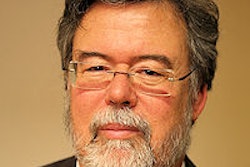
VIENNA - A way to lower CT dose, particularly for children, who are the most sensitive to radiation, was unveiled today at ECR 2016 and doesn't require additional hardware or staff. Called the "half-slice thickness" approach, it uses existing resources and knowledge.
Every year, study after study is presented on radiation dose, discussing ways to lower it. Many societies have sprung up to address the problem -- particularly for pediatrics -- but are any of the recommendations being translated into action? "Not really," according to Dr. Erich Sorantin, professor and acting head of the Division of Pediatric Radiology at Medical University of Graz in Austria.
"Why does it happen?" he said during the ECR 2016 opening press conference. "My answer is there are a lot of efforts we do on different levels, but distribution of these efforts and penetration of brains is a completely different thing."
Also, many people wrongly believe that technology boards will develop better systems, but that isn't happening.
 The half-slice thickness protocol proposed by Sorantin.
The half-slice thickness protocol proposed by Sorantin.To counteract this, Sorantin has proposed an easy and simple solution: half-slice thickness. The theory exploits the inverse relationship between image noise and dose. To obtain the same image quality at half-slice thickness, double the dose is needed. To achieve a dose reduction, the process is reversed: After a study and discharge, radiographers reconstruct the study with half-slice thickness and radiologists check the image quality. If the diagnostic quality is still appropriate, then 100% excess dose is used.
The dose for the next study is reduced by 20% and the process should be repeated until the image quality is no longer diagnostically acceptable.
"Only hearing lectures won't change the world," he said in an interview with AuntMinnieEurope.com. Something needs to be done, and he thinks half-slice thickness is a good possibility.
"The radiologist is responsible. They are thinking it is the responsibility of the other professions to do it -- it's something for everyone else to do -- and then nothing gets done," he said.
In the future, Sorantin would like to hold workshops on the approach with three different levels: basic, advanced, and licensing.
Editor's note: Be sure to view our ECR 2016 interview with Dr. Erich Sorantin. He elaborates on how the "half-slice thickness" technique works.



















